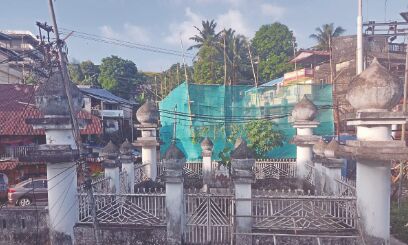Unearthing tragedy
Recounting the grim history behind Sunny’s Mazar in Aberdeen Bazar — a fading symbol of the brutal Japanese occupation of Andaman & Nicobar during the Second World War

Aberdeen Bazar, located in the heart of Port Blair, is usually bustling with activity. It is dotted with hotels, guest houses, restaurants and shops. A big clock tower adorns the Bazar. The historic Cellular Jail, the Marina Park, the Sports Complex are all located nearby. Behind one of the streets of the Bazar, lies a white coloured Mazar known as Sunny's Mazar. Most people pass by the Mazar without even looking at it.
Who was Sunny? Why is the Mazar named after him? Zulfikar Ali, popularly known as Sunny, was a dashing young man in the prime of his youth when he was brutally killed by the troops of the Imperial Japanese Army in March 1942. Sunny belonged to a family of Punjabi Muslim traders who had made Port Blair their home.
During the Second World war, Japan had overrun most of East Asia. Rangoon fell in March 1942 and very soon it was the turn of the Andaman & Nicobar Islands. On March 23, 1942, the Japanese forces landed in Port Blair. They encountered no resistance since the British (barring the Chief Commissioner and his deputy) had already fled to the mainland.
For a while, everything seemed to be going well for the Islanders. Very soon, however, the true colours of the Imperial Japanese Army were revealed to the Islanders. In the territories occupied by them during the war, the Japanese had inflicted terrible atrocities upon the local population. In Korea, China, Malaysia and other places, many local women were forced into becoming "Comfort Girls" for the occupying Japanese forces.
The Japanese behaved no differently in Port Blair. They would often enter houses of residents, thrash them and snatch the women who caught their eye. One day in March 1942, Japanese troops barged into houses located in the Aberdeen Bazar area and tried to molest the women.
Just then, Sunny came out of his house and fired from his air gun. The Japanese troops backed off but only for the time being. They returned the next day and searched all the houses in the area looking for Sunny. However, they could not apprehend Sunny. They then threatened the residents with dire consequences in case Sunny was not handed over to them in a couple of days.
Finally, Sunny decided to spare his friends, relatives and neighbours of the "consequences". When the Japanese again came looking for him, he bravely surrendered to the Japanese thereby sparing his loved ones of further misfortune. Sunny was marched to the open ground in front of his house and then, in full public view, brutally thrashed and eventually shot dead by the Japanese. None of the onlookers spoke up for him or came to his rescue.
Sunny was later buried by his family in the courtyard of his house. After the War, his family built a Mazar in his memory. When I was first posted in Port Blair in 1995, I found Sunny's Mazar to be a fairly well-known location. However, when I returned to Port Blair in 2016 for my next posting, I found that very few people knew about Sunny's Mazar. Although located in the heart of the tourist area of the town, hardly any tourist today visits the Mazar. Sadly, even the younger generation of the locals have only a vague idea about Sunny.
Thanks to the efforts of his family and friends, Sunny's Mazar will keep his memory, however hazy it may be, alive for posterity. But what about the other victims? There were many victims of Japanese atrocities in the Islands. In one of the most gruesome incidents of the war, the Japanese forces forcibly herded nearly 600 innocent civilians in three boats and threw them off the same in the sea near Havelock Island. One person survived to tell the tale. Nearly 300 villagers were shot dead in Tarmugli Island near Port Blair in 1945. Similar atrocities were inflicted by the Japanese on the tribal people of Car Nicobar and Nancowry.
The Second World War was the most terrible event in human history. However, after the war, in most countries, the tragic events of the war have been very well documented and the memories of both the military and civilian victims of the war have been kept alive in memorials dedicated to them. This has possibly brought about reconciliation between the victors and the vanquished. In the heart of Berlin, for example, there is a memorial to the Jews whom the Nazis had exterminated. Another memorial to the Roma people is located nearby.
Over the years, memories of these tragic events during the Japanese occupation of the Andaman & Nicobar Islands are receding. Maybe this dark chapter in our history will be obliterated in future. It is up to us to see that this does not happen.
The writer is the former-Chief Secretary, Andaman & Nicobar Administration. Views expressed are personal



